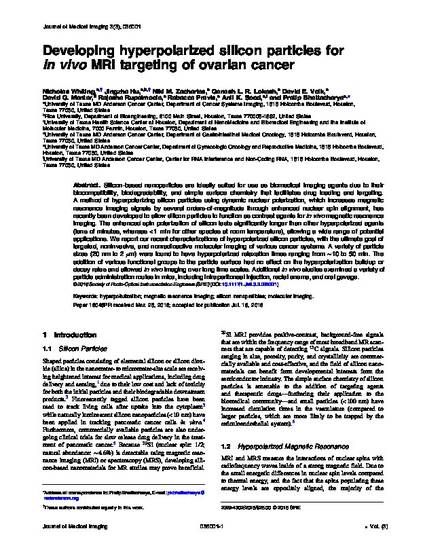
Article
Developing hyperpolarized silicon particles for in vivo MRI targeting of ovarian cancer
Journal of Medical Imaging
(2016)
Abstract
Silicon-based nanoparticles are ideally suited for use as biomedical imaging agents due to their biocompatibility, biodegradability, and simple surface chemistry that facilitates drug loading and targeting. A method of hyperpolarizing silicon particles using dynamic nuclear polarization, which increases magnetic resonance imaging signals by several orders-of-magnitude through enhanced nuclear spin alignment, has recently been developed to allow silicon particles to function as contrast agents for in vivo magnetic resonance imaging. The enhanced spin polarization of silicon lasts significantly longer than other hyperpolarized agents (tens of minutes, whereas <1 min for other species at room temperature), allowing a wide range of potential applications. We report our recent characterizations of hyperpolarized silicon particles, with the ultimate goal of targeted, noninvasive, and nonradioactive molecular imaging of various cancer systems. A variety of particle sizes (20 nm to 2 μm) were found to have hyperpolarized relaxation times ranging from ∼10 to 50 min. The addition of various functional groups to the particle surface had no effect on the hyperpolarization buildup or decay rates and allowed in vivo imaging over long time scales. Additional in vivo studies examined a variety of particle administration routes in mice, including intraperitoneal injection, rectal enema, and oral gavage.
Disciplines
Publication Date
August 10, 2016
DOI
10.1117/1.JMI.3.3.036001
Citation Information
Nicholas Whiting, Jingzhe Hu, Niki M. Zacharias, Ganesh L. R. Lokesh, et al.. "Developing hyperpolarized silicon particles for in vivo MRI targeting of ovarian cancer" Journal of Medical Imaging Vol. 3 Iss. 3 (2016) p. 36001 - 36001 Available at: http://works.bepress.com/nicholas-whiting/4/
